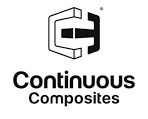


Steered continuous fiber toolpathing involves part slicing, defining anchor/source toolpaths, and intelligent toolpath replication.
Problem
In the continous fiber 3D printing industry, there is a gap in printability between the part geometries that can be designed and those currently produced by state-of-the-art continuous fiber printers. Specifically, steered continuous fiber (SCF) toolpath planning software lags physical SCF printing capability. To date, there is no slicing or toolpathing software available that enables a designer to efficiently specify SCF within complex and highly-curved 3D geometries to achieve fiber orientation parity with finite element analysis (FEA) load simulation guidance.
Objective
The objective of this project is to develop a user interface and toolpathing approach that is fully 3D-centric. This will include a variable slicing perspective and a library of intelligent toolpath replication algorithms. The end result will be a collection of functional building blocks that designers can use to efficiently define fiber pathways. Additionally, the project will establish downstream interoperability with industry finite element analysis software.
Technical Approach
Continuous Composites, Inc. (CCI) CF3D® Toolpathing Studio software will be leveraged to provide an application codebase and 3D slicing surface computer-aided design (CAD) models imported by the designer. CCI engineers will develop new SCF toolpathing algorithms and then test the functionality of each algorithm through a sample part. Toolpathed parts will be exported to a CF3D printing platform digital twin on the Siemens Run My Virtual Machine simulator for confirmation. Once the functionality is confirmed, C++ programming language algorithms and capability demonstrating visuals and files will be delivered. To achieve downstream interoperability of SCF software and FEA, CCI will work with two FEA vendors to develop a standard for multi-fiber, multi-material SCF toolpath data. This standard will be free of motion data and include a translation utility to import data into the vendors’ standards. The downstream interoperability of FEA will be improved by developing a toolpath data standard to a post-trim model reconciliation algorithm to account for expected post-machining of the print.
Project Participants
Project Principal

Other Project Participants
- Air Force Research Laboratory (AFRL)
Public Participants
- U.S. Department of Defense
